Solar eclipse of February 14, 1934
A total solar eclipse occurred on February 14, 1934. A solar eclipse occurs when the Moon passes between Earth and the Sun, thereby totally or partly obscuring the image of the Sun for a viewer on Earth. A total solar eclipse occurs when the Moon's apparent diameter is larger than the Sun's, blocking all direct sunlight, turning day into darkness. Totality occurs in a narrow path across Earth's surface, with the partial solar eclipse visible over a surrounding region thousands of kilometres wide. Totality was visible from the Dutch East Indies (today's Indonesia), North Borneo (now belonging to Malaysia), and South Pacific Mandate in Japan (the part now belonging to FS Micronesia).
| Solar eclipse of February 14, 1934 | |
|---|---|
 Map | |
| Type of eclipse | |
| Nature | Total |
| Gamma | 0.4868 |
| Magnitude | 1.0321 |
| Maximum eclipse | |
| Duration | 173 sec (2 m 53 s) |
| Coordinates | 13.2°N 161.7°E |
| Max. width of band | 123 km (76 mi) |
| Times (UTC) | |
| Greatest eclipse | 0:38:41 |
| References | |
| Saros | 139 (25 of 71) |
| Catalog # (SE5000) | 9360 |
Related eclipses
Solar eclipses 1931–1935
This eclipse is a member of a semester series. An eclipse in a semester series of solar eclipses repeats approximately every 177 days and 4 hours (a semester) at alternating nodes of the Moon's orbit.[1]
| Solar eclipse series sets from 1931–1935 | |||||
|---|---|---|---|---|---|
| Descending node | Ascending node | ||||
| 114 | September 12, 1931 Partial |
119 | March 7, 1932 Annular | ||
| 124 | August 31, 1932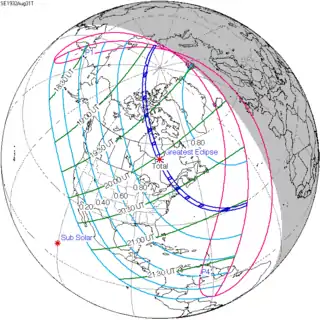 Total |
129 | February 24, 1933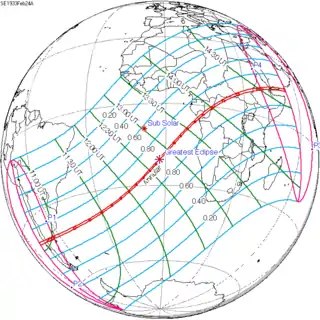 Annular | ||
| 134 | August 21, 1933 Annular |
139 | February 14, 1934 Total | ||
| 144 | August 10, 1934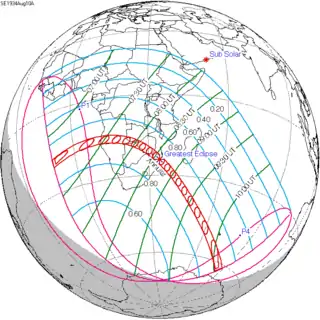 Annular |
149 | February 3, 1935 Partial | ||
| 154 | July 30, 1935 Partial | ||||
Saros 139
It is a part of saros series 139, repeating every 18 years, 11 days, 8 hours, containing 71 events. The series started with partial solar eclipse on May 17, 1501. It contains hybrid eclipses on August 11, 1627 through to December 9, 1825 and total eclipses from December 21, 1843 through to March 26, 2601. The series ends at member 71 as a partial eclipse on July 3, 2763. Its eclipses are entabulated in three columns; each one in the same column, every third eclipse, is one exeligmos apart so cast shadows over approximately the same parts of the earth.
The solar eclipse of June 13, 2132 will be the longest total solar eclipse since July 11, 1991 at 6 minutes, 55.02 seconds.
The longest duration of totality will be produced by member 39 at 7 minutes, 29.22 seconds on July 16, 2186.[2] After that date each duration will decrease, until the series end. This date is the longest solar eclipse computed between 4000BC and 6000AD.[3] Saros series eclipses are during the Moon’s ascending node (a term related to our equator and polar-naming conventions).
| Series members 24–45 occur between 1901 and 2300 | ||
|---|---|---|
| 24 | 25 | 26 |
 February 3, 1916 |
 February 14, 1934 |
 February 25, 1952 |
| 27 | 28 | 29 |
 March 7, 1970 |
 March 18, 1988 |
 March 29, 2006 |
| 30 | 31 | 32 |
 April 8, 2024 |
 April 20, 2042 |
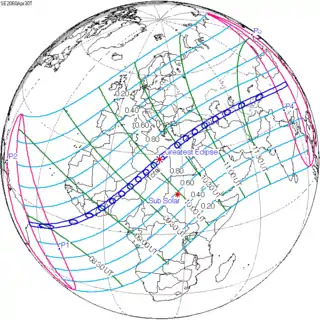 April 30, 2060 |
| 33 | 34 | 35 |
 May 11, 2078 |
 May 22, 2096 |
 June 3, 2114 |
| 36 | 37 | 38 |
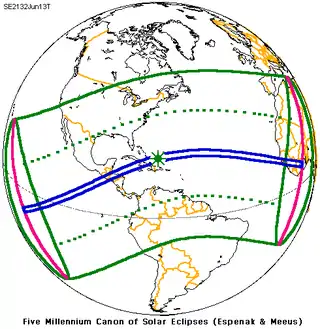 June 13, 2132 |
 June 25, 2150 |
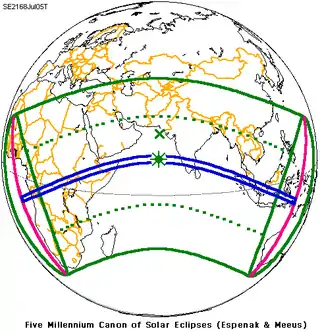 July 5, 2168 |
| 39 | 40 | 41 |
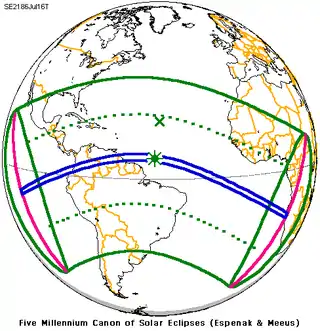 July 16, 2186 |
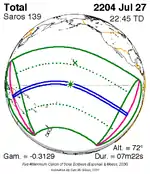 July 27, 2204 |
 August 8, 2222 |
| 42 | 43 | 44 |
 August 18, 2240 |
 August 29, 2258 |
 September 9, 2276 |
| 45 | ||
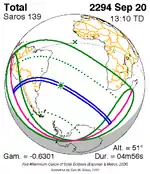 September 20, 2294 | ||
Notes
- van Gent, R.H. "Solar- and Lunar-Eclipse Predictions from Antiquity to the Present". A Catalogue of Eclipse Cycles. Utrecht University. Retrieved 6 October 2018.
- Saros Series Catalog of Solar Eclipses NASA Eclipse Web Site.
- Ten Millennium Catalog of Long Solar Eclipses, -3999 to +6000 (4000 BCE to 6000 CE) Fred Espenak.
References
- Earth visibility chart and eclipse statistics Eclipse Predictions by Fred Espenak, NASA/GSFC
.jpg.webp)

